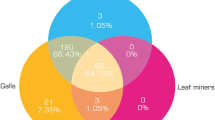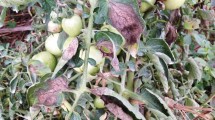Abstract
A large collection of German rye leaf rust isolates was analysed to characterize the diversity, spatial variation and temporal dynamics of virulences. Virulence-avirulence phenotypes (=pathotypes) were determined on 23 host differentials. We found 93 pathotypes among 177 single-uredinial isolates in 2000, 201 pathotypes among 437 isolates in 2001, and 125 pathotypes among 213 isolates in 2002. In total, the 827 analyzed isolates represented 317 pathotypes. Frequency of virulences on the individual differentials varied from 2% to 97%. Eight of the differentials showed a high resistance level with virulence frequencies <10%. Virulence complexity of the isolates ranged from 3 to 21 with a mean of nine. The percentages of highly virulent isolates (>14 virulences) increased from 4 to 15% during the sampling period. A high level of virulence diversity was observed within and between individual sampling sites with Simpson indices around 0.9. Evenness indices ranged from 0.88 to 0.92. Four of the five most frequent pathotypes were found in each year but their frequency never exceeded 10%. Isolates with unusual virulence combinations could be clearly separated by principal component analysis. Location-specific pathotype frequencies were revealed in each year, but the frequency patterns varied across years. On four fields a considerable increase of highly virulent pathotypes occurred within 6 weeks during the epidemic. The high diversity of pathotypes as well as the fast accumulation of highly virulent pathotypes favour the adaptation of the pathogen to race-specific host resistances. More durable resistance might be achievable by combining new effective race-specific resistances with adult-plant and/or race-non-specific quantitative resistances.





Similar content being viewed by others

References
Anikster, Y., Bushnell, W. R., Eilam, T., Manisterski, J., & Roelfs, A. P. (1997). Puccinia recondita causing leaf rust on cultivated wheats, wild wheats, and rye. Canadian Journal of Botany, 75, 2082–2096.
Anonymous. (1998). Descriptive list of recommended varieties for cereals, maize, oil and fiber crops, legumes, beet and intermediate crops [In German]. Hannover: Strothe Verlag.
Anonymous. (2001). Descriptive list of recommended varieties for cereals, maize, oil and fiber crops, legumes, beet and intermediate crops [In German]. Hannover: Strothe Verlag.
Bayles, R. A., Flath, K., Hovmøller, M. S., & de Vallavielle-Pope, C. (2000). Breakdown of the Yr17 resistance to yellow rust of wheat in Northern Europe. Agronomie, 20, 805–811.
Böker, F. (2010): Analyse mehrdimensionaler Daten. Vorlesungsskript Universität Göttingen, Institut für Statistik und Ökonometrie. Internet resource: http://www.statoek.wiso.uni-goettingen.de/cms/user/index.php?lang=de§ion=teaching.ws2009.multivariate.notizen, (verified May 12, 2011).
FAOSTAT (2010). Production. Crops. Internet resource: http://faostat.fao.org/site/567/default.aspx#ancor (verified June 13, 2011)
Felsenstein, F. G., & Jaser, B. (2000). Effectiveness of vertical (qualitative) resistance to powdery mildew in wheat and barley, Report 2000. [In German]. Freising: EpiLogic GmbH. Internet resource: http://www.epilogic.de/BL%202000%20Bericht%20farbig%20hoch.htm. (verified June 13, 2011).
Frauenstein, K., & Reichel, A. (1978). Recognition of slow-rusting in leaf rust of rye (Puccinia recondita Rob. ex Desm.). [In German]. Wissenschaftliche Beiträge der Martin-Luther-Universität Halle, 14, 403–411.
Gassner, G., & Kirchhoff, H. (1934). Some experiments for the detection of biological races within rye leaf rust P. dispersa Erikss. et Henn. Phytopathologische Zeitschrift, 7, 479–486.
Geiger, H. H., & Miedaner, T. (2009). Rye breeding. In M. J. Carena (Ed.), Cereals (handbook of plant breeding) (1st ed., pp. 157–181). New York: Springer.
Goyeau, H., Park, R., Schaeffer, B., & Lannou, C. (2006). Distribution of pathotypes with regard to host cultivars in French wheat leaf rust populations. Phytopathology, 96, 264–273.
Goyeau, H., Halkett, F., Zapater, M.-F., Carlier, J., & Lannou, C. (2007). Clonality and host selection in the wheat pathogenic fungus Puccinia triticina. Fungal Genetics and Biology, 44, 474–483.
Hartleb, H., Hartmann, G., Wolff, Ch, & Rücker, P. (1995). Yield effect of leaf rust in wheat and rye (Puccinia recondita Rob. ex Desm.) and barley (Puccinia hordei Otth) in differently resistant varieties in Saxony-Anhalt. [In German]. Gesunde Pflanzen, 47, 59–64.
Hau, B., & de Vallavieille-Pope, C. (2006). Wind-dispersed diseases. In B. M. Cooke, D. Gareth Jondes, & B. Kaye (Eds.), The epidemiology of plant diseases (2nd ed., pp. 387–408). Niederlande: Springer Verlag.
Heckelbacher, B., Brodny, U., Anikster, Y., Fischbeck, G., & Wahl, I. (1992). Patterns of host-parasite interactions in natural populations of Hordeum spontaneum and endemic races of Erysiphe graminis. Vorträge für Pflanzenzüchtung, 24, 203–205.
Klocke, B. (2004): Virulence structure and dynamics of rye leaf rust (Puccinia recondita f. sp. secalis) in Germany [In German] (140 pp). PhD. thesis. Univ. Halle, http://sundoc.bibliothek.uni-halle.de/diss-online/04/04H168/index.htm (verified June 13, 2011).
Kobylanski, V. D., & Solodukhina, O. V. (1996). Genetic basis and practical breeding utilization of heterogeneous resistance of rye to brown rust. Vortraege für Pflanzenzuechtung, 35, 155–163.
Kolmer, J. A. (2002). Virulence phenotypes of Puccinia triticina in the South Atlantic States in 1999. Plant Disease, 86, 288–291.
Kosman, E. (1996). Difference and diversity of plant pathogen populations: a new approach for measuring. Phytopathology, 86, 1152–1155.
Leßner, B., & Sperling, U. (1995). Characterisation of rye leaf lust isolates by rye inbred lines. [In German]. In Bericht über die 46. Arbeitstagung 1995 der Arbeitsgemeinschaft der Saatzuchtleiter im Rahmen der “Vereinigung österreichischer Pflanzenzüchter”, Gumpenstein, November 1995, (pp. 21–23). Gumpenstein: Bundesanstalt für alpenländische Landwirtschaft.
Limpert, E., Schwarzbach, E., & Fischbeck, G. (1984). Distribution of virulence in the European population of barley mildew Erysiphe graminis f. sp. hordei. Vorträge für Pflanzenzüchtung, 6, 1–21.
Long, D. L., Kolmer, J. A., Leonard, K. J., & Hughes, M. E. (2002). Physiologic specialization of Puccinia triticina on wheat in the United States 2000. Plant Disease, 86, 981–986.
Löwer, C. (2000). Coevolution between Hordeum spontaneum und Erysiphe graminis f. sp. hordei in populations of West Turkey [In German]. Aachen: Shaker Verlag (184 pp).
Mains, E. B. (1926). Rye resistant to leaf rust, stem rust, and powdery mildew. Journal of Agricultural Research, 32, 201–221.
McCallum, B. D., Seto-Goh, P., & Xue, A. (2010). Physiological specialization of Puccinia triticina in Canada in 2007. Canadian Journal of Plant Pathology, 32, 229–236.
McDonald, B. A., & Linde, C. (2002). Pathogen population genetics, evolutionary potential, and durable resistance. Annual Review of Phytopathology, 40, 349–379.
Mesterházy, A., Bartos, P., Goyeau, H., Niks, R. E., Csosz, M., Andersen, O., et al. (2000). European virulence survey for leaf rust in wheat. Agronomie, 20(7), 793–804.
Miedaner, T., & Sperling, U. (1995). Effect of leaf rust on yield components of winter rye hybrids and assessment of quantitative resistance. Journal of Phytopathology, 143, 725–730.
Miedaner, T., Gey, A.-K. M., Sperling, U., & Geiger, H. H. (2002). Quantitative-genetic analysis of leaf-rust resistance in seedling and adult-plant stages of inbred lines and their testcrosses in winter rye. Plant Breeding, 121, 475–479.
Müller, K., McDermott, J. M., Wolfe, M. S., & Limpert, E. (1996). Analysis of diversity in populations of plant pathogens: the barley powdery mildew pathogen across Europe. European Journal of Plant Pathology, 102, 385–395.
Park, R. F., & Felsenstein, F. G. (1998). Physiological specialization and pathotype distribution of Puccinia recondita in Western Europe in 1995. Plant Pathology, 47, 157–164.
Roelfs, A. P., Singh, R. P., & Saari, E. E. (1992). Rust diseases of wheat: Concepts and methods of disease management. Mexico, D.F.: CIMMYT, 81 pages.
Roux, S. R., Hackauf, B., Linz, A., Ruge, B., Klocke, B., & Wehling, P. (2004). Leaf-rust resistance in rye (Secale cereale L.). 2. Genetic analysis and mapping of resistance genes Pr3, Pr4, and Pr5. Theoretical and Applied Genetics, 110, 192–201.
SAS Institute Inc. (1999). SAS/STAT® user’s guide, version 8. Cary, NC.
Schwarzbach, E. (1979). A high throughput jet trap for collecting mildew spores on living leaves. Phytopathologische Zeitschrift, 94, 165–171.
Smith, L. (2002): A tutorial on principal components analysis. Internet resource: http://www.cs.otago.ac.nz/cosc453/student_tutorials/principal_components.pdf (verified May 12, 2011).
Thrall, P. H., & Burdon, J. J. (2003). Evolution of virulence in a plant host-pathogen metapopulation. Science, 299, 1735–1737.
Wehling, P., Linz, A., Hackauf, B., Roux, S. R., Ruge, B., & Klocke, B. (2003). Leaf-rust resistance in rye (Secale cereale L.). 1. Genetic analysis and mapping of resistance genes Pr1 and Pr2. Theoretical and Applied Genetics, 107, 432–438.
Welz, G. (1986). Structure and dynamics of virulences in populations of Erysiphe graminis f. sp. hordei Marchal. [In German]. Ph.D.thesis, Univ. Gießen.
Wilde, K., Geiger, H. H., & Miedaner, T. (2006). Significance of host complexity and diversity for race-specific leaf-rust resistance in self-fertile synthetic rye populations. Plant Breeding, 125, 225–230.
Wolfe, M. S., & Finckh, M. R. (1997). Pathogen population biology and disease control. In H. Hartleb, R. Heitefuss, & H.-H. Hoppe (Eds.), Resistance of crop plants against fungi (pp. 3–50). Jena: Fischer-Verlag.
Acknowledgments
We thank Dr. H.Wortmann (Hybro Saatzucht GmbH & Co. KG), Mrs. B. Schmiedchen and Dr. P. Wilde (KWS LOCHOW GMBH), and Dr. E. Knopf (Dieckmann Seeds GmbH & Co. KG) for their long-lasting interest and support of this study and Mrs. B. Pietschmann for technical assistance. The Julius-Kühn-Institute, Breeding Research on Agricultural Crops, Groß Lüsewitz, and Agricultural Research Institute of Non-Chernozem Zone (Prof. Dr. A.A. Goncharenko, Nemchinovka near Moskow) both contributed generously genetic materials.
Author information
Authors and Affiliations
Corresponding author
Additional information
T. Miedaner and B. Klocke contributed equally to this paper.
Electronic supplementary material
Below is the link to the electronic supplementary material.
Supplemental Figure 1
Virulence pattern of the six most frequently isolates pathotypes (please refer to Table 4). (DOCX 27 kb)
Rights and permissions
About this article
Cite this article
Miedaner, T., Klocke, B., Flath, K. et al. Diversity, spatial variation, and temporal dynamics of virulences in the German leaf rust (Puccinia recondita f. sp. secalis) population in winter rye. Eur J Plant Pathol 132, 23–35 (2012). https://doi.org/10.1007/s10658-011-9845-8
Accepted:
Published:
Issue Date:
DOI: https://doi.org/10.1007/s10658-011-9845-8



